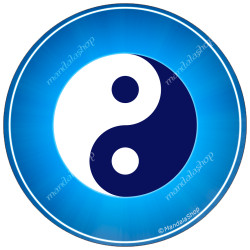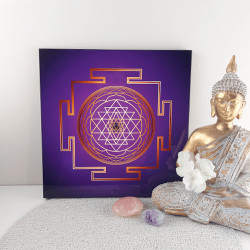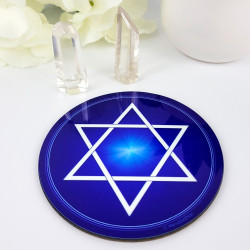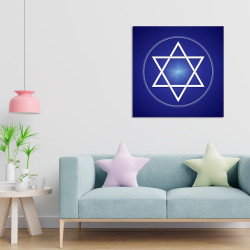The mystery of geometric figures

For a long time, geometrical figures were regarded as mere lifeless figures (as they can be in mathematics...). The worry is that this has contributed to the degradation of their original meaning, their depth and their true symbolism. Yet these elementary shapes are much more than mere mathematical constructs: they are the very foundations of the universe and the principles that govern it.
For Omraam Mikhaël Aïvanov, as for others, geometrical figures are not simply abstract entities described by mathematical theorems. They represent living symbols, keys to understanding the mysteries of the universe and of human consciousness. In his vision, every line, every angle, every geometric shape carries a profound meaning, a resonance with the cosmic laws that govern existence. For Aivanov, exploring geometrical figures means delving into the secrets of universal harmony, discovering the truths hidden behind material appearances. From this perspective, triangles, circles, squares and other shapes are of spiritual importance, offering valuable teachings for those who are ready to understand them.
In this article I invite you to forget all the concepts you've learned about geometrical figures in school, and rediscover their true essence, rich in spiritual, symbolic and philosophical meaning.
As Omraam Mikhaël Aïvanov said,"It's important to study symbols, because the symbol is the language of Nature itself. But for most people, this language is still indecipherable".
What is a geometric figure? Definition
If we had to summarize what a geometric figure is, from a purely basic point of view (without the wisdom), I'd say that a geometric figure is a visual representation of a shape in mathematical space. These shapes can be as simple as straight lines or circles, or as complex as polygons, polyhedrons or curves. Geometric figures are the basis for many mathematical concepts, such as measurement, analytic geometry, trigonometry and Euclidean geometry. They are used to describe and analyze objects in space, as well as to solve mathematical problems and apply geometric principles to various fields of science and engineering. In short, you don't really know what you're studying at school (if you remember!).
In esotericism, the definition is quite different, since a geometrical figure is not just an abstract or mathematical form, but is rather perceived as a symbol charged with spiritual and mystical meanings. These figures are interpreted beyond their physical appearance to reveal hidden truths about the nature of the universe and of mankind. For example, the circle may represent eternity and unity, the square stability and order, the triangle balance and trinity. You get the idea.
From an esoteric point of view, each geometric shape becomes a portal, a doorway, to a deeper understanding of cosmic and spiritual principles. For this reason, they are often used in meditation, visualization and other spiritual practices to foster connection with higher realities and stimulate personal and spiritual growth. In this way, a geometrical figure in esotericism goes beyond its mathematical aspect to become a powerful tool for inner exploration and spiritual transformation.
What are the simple geometric figures and their symbolism?
Symbolism of the point
The point is not a geometric figure, but you'll see why it's important to talk about it next.
It's true that a point may seem like a small, unassuming thing, the first mark on a blank sheet of paper. In this case, the dot is a start. But do you see what just happened there? The period, an essential element of sentence structure, closed it, making it a symbol of the end.
Consequently, the point is both an origin and a conclusion, encompassing all the possibilities of the Universe within it, a seed full of potential and a symbol of the Supreme Being.
The point is the point of creation, for example where the arms of the cross meet. The point is also called bindhu, meaning "drop". The bindhu is a symbol of the Absolute, marked on the forehead at the site of the third eye, believed to be the seat of the soul. The presence of dots in a symbol can signify the presence of something else. A dot in the center of the Star of David marks the quintessence, or Fifth Element. It also recalls the notion of space. The decorated dots surrounding the doors of oriental temples are not mere ornamental devices, but have a special meaning for the faithful. The dots frequently appear in this way, acting as a kind of shorthand for the principles of a faith. In the Jain symbol, for example, the dots represent the three jewels of Jainism. The dots in each half of the yin-yang symbol unify the two halves: one dot is "yin", the other "yang". Together, they demonstrate the interdependence of opposing forces.

"The initiates have always taught the importance of a center to which man must always bind himself, for they know that if there isn't a central point around which particles, atoms and worlds revolve, everything falls apart: it's chaos". O.M. AIvanhov in "The language of geometric figures"
Circle symbolism
The next logical magic symbol is the circle. Essentially an expansion of the dot, the circle represents spirit and the cosmos. What's more, the circle itself is constructed from "something" (the unbroken line) and "nothing" (the space inside and outside that line). The circle thus unifies mind and matter. The structure itself is of great solidity: think of the cylindrical shape of a lighthouse, built in this way to withstand the fiercest attacks of a raging sea. The physical and spiritual strength of this symbol is there because the perfect circle has no beginning and no end; it's unassailable. This power is the reason why the circle is used in magical practices such as spell casting. The magic circle creates a fortress of psychic protection, a physical and spiritual refuge where unwanted or uninvited entities cannot enter.
Hermes Trismegistus says of the circle: God is a circle whose center is everywhere and whose circumference is nowhere. Where would ancient man have seen the most important circles? Obviously, the Sun and Moon. Like the Sun, the circle is masculine, but when it's the Moon, it's feminine. Because the passage of time is marked by the journey of the Sun, Moon and stars in orbit around our Earth, the circle is a symbol of the passage of time. In this form, it generally appears as the wheel. Because the circle has no divisions or sides, it is also a symbol of equality. King Arthur's round table was the ideal piece of furniture for the camaraderie of knights, who were each as important as the next. Similarly, the Dalai Lama has a "circular" Council.
The circle, an omnipresent symbol in all cultures and throughout the ages, embodies the sun, the source of life on Earth. It evokes unity, wholeness, enlightenment, the cycle of life and rebirth, the wheel of life, the philosopher's stone and, in many religious traditions, the all-seeing eye.
Representing a universal significance, the circle may well be the first shape drawn by mankind, under the influence of the sun. Without beginning or end, it symbolizes eternity, perfection, divinity, infinity, completion and supreme cosmic order. It reflects the cycles of the natural world, embodying unity and illustrating the example of King Arthur's Round Table.
Often depicted as a dragon or a snake biting its tail (the Ouroboros), the circle represents eternity and the infinite cycle of change. The circled cross, found in many religious works, is considered an example of squaring the circle.
In the guise of a wheel, the circle symbolizes movement. The Dharma Wheel, a Buddhist symbol, represents the ever-expanding teachings of the Buddha. The Tibetan prayer wheel contains an infinite prayer in its cylinder. Associated with luck because of its movement, the Wheel of Fortune embodies this aspect of the circle.
According to Carl Jung, the circle represents natural processes, the cosmos and the cycles of the universe, while the square symbolizes the universe as man conceives and projects it.
Square symbolism
Considered the first shape invented by man, the square represents the created Universe, as opposed to the spiritual dimensions represented by the circle. The square represents the Earth and the four elements. Plato described the square, like the circle, as "absolutely beautiful in itself". Like the cross, the square is associated with the number 4. A square has four corners; to speak of "the four corners of the Earth" is something of an anomaly, since the Earth is round, without corners. All the symbolism of the number 4 is embodied in the square, and it's interesting to note that, just as the square represents the created Universe, in the Hebrew faith, the Holy Name of the Creator is made up of four letters.
The square gives man a static and secure point of reference, as well as a stable and immobile form, as opposed to the continuous movement of the circle. Temples and sacred buildings are often built in the shape of a square, solidly designed to align with the four cardinal points. The Kaaba in Mecca is a fine example, as is the base of the Buddhist Stupa. Altars, too, are square. Square shapes define limits and create boundaries; to speak of someone as "square" means they are fixed and unchanging.
According to Pythagoras, the square was synonymous with perfection, embodying robustness and stability, as opposed to the circle, which symbolized Heaven. Divisible into two equal parts, the square can then be subdivided into multiples of two. When inscribed with a cross, it fragments into eight triangles, evoking the eight cardinal points and the four corners of the world.
In ancient Egypt, the square hieroglyph represented fulfillment. In Buddhism, the square or cube forms the base of the stupa, symbolizing the earthly plane of existence. It also forms the base of the Hindu temple and all other sacred structures. The square is considered the archetype and model of universal order, as well as the reference in terms of proportions. The use of the expression "square" is a talismanic promise of stability and permanence.
Triangle symbolism
The symbolism of the triangle, as a shape, is based on the number 3. As such, it represents elements such as the Holy Trinity and the Triple Goddess, both based on the number 3. Indeed, in many religious and esoteric traditions, the triangle evokes the Trinity or triple divinity, often symbolizing the Father, Son and Holy Spirit in Christianity, or the three aspects of divinity in other belief systems. It also represents the balance between the divine, the human and the spiritual.
The triangle can also be interpreted as representing the three components of the human being: body, mind and soul. This reflects the idea of harmonizing these three aspects to achieve a state of integrity and wholeness.
In his book "The Language of Geometric Figures", Omraam Mikhael Aïvanhov points out that the triangle is the masculine and feminine principles uniting to give birth to a third principle. Interestingly, he notes that only the equilateral triangle gives us the idea of perfect harmony, because it expresses the harmony between the three principles: none has developed at the expense of the others. It's the symbol of the harmoniously developed human being, and it's also the symbol of Divinity.
As a geometric shape, the triangle is often associated with stability and power. Its triangular structure gives it a solidity that makes it a symbol of strength and resistance.
Sometimes the triangle can also represent the process of human evolution and spiritual growth. The three sides of the triangle symbolize the initiate's journey through the stages of purification, illumination and union with the divine.
In alchemy and other esoteric traditions, the triangle is sometimes used to represent the four elements: earth, air, fire and water. It thus embodies the harmony and balance between these cosmic forces.

Triangles appear in many different signs and symbols.
In ancient times, the triangle was considered synonymous with light, and its meanings vary according to the direction it is facing. When it rests firmly on its base, it is a masculine and virile symbol, representing fire. In the opposite direction, it becomes a chalice-shaped water element, emblematic of feminine powers. Thus balanced at the tip, the triangle also represents the yoni (female genital organ), reinforcing the Goddess aspect.
The equilateral triangle is a harmonious shape, used to indicate higher powers, providing a framework, for example, for God's all-seeing eye. A symbol of strength, the triangle reinforces the corners of the square, both physically and metaphysically. The solid form of the triangle also makes its appearance in yogic postures, for example in the Trikona Asana or Triangle Posture.
The triangle is mystical and divine because it is the bearer of trinity, resurrection and light. Indeed, in reference to the solar principle, it is found in the pyramid. Depending on its orientation, it is either masculine (fire, heaven) or feminine (water, hell). Its summit is a place of spirituality.
You're all familiar with the hexagram, the 6-pointed star also known as the Seal of Solomon.
This figure is formed by two intersecting triangles: the triangle pointing down represents the masculine principle, and the triangle pointing up represents the feminine principle. Why is this so? Because the feminine principle, matter, is always turned towards the sky, towards the spirit; it waits for the spirit to come and fertilize it, to animate it.
The masculine principle, spirit, is turned towards the bottom: it descends towards matter to bring it everything it possesses.
Solomon's Seal is the symbol of all beings who have succeeded in developing and balancing within themselves the two masculine and feminine principles, emissive and receptive.
A final word
I hope this article has given you a deeper understanding of geometrical figures than just their mathematical constructs! In many esoteric traditions, these figures have a profound spiritual significance. They provide keys to understanding the mysteries of the universe and human consciousness.
Whether it's the circle representing eternity and unity, the square symbolizing stability and order, or the triangle evoking trinity and divine balance, each geometric shape offers a gateway to a deeper understanding of our existence and our relationship with the cosmos.
By meditating on the symbols, bringing them to life within you and exploring their hidden meanings, you can find inspiration, guidance and awakening to higher levels of consciousness. I used to say that symbols can be wonderful tools and companions because they show us how we truly need to be. They are invaluable tools for your spiritual growth and your quest for truth in this complex and wonderful world of ours.
If you liked this article, please feel free to comment, share and subscribe to our newsletter to be informed of future issues.
Sources
Les symboles mystiques, Éditions Véga
The language of geometric symbols, Éditions Prosveta



















 Christmas Tree Star: The True Meaning
Christmas Tree Star: The True Meaning
 Meaning of the Infinity Symbol: A Journey Toward Eternity
Meaning of the Infinity Symbol: A Journey Toward Eternity
 Symbolism of the circle: the mystery of a perfect shape
Symbolism of the circle: the mystery of a perfect shape
 Healthy mind in a healthy body: regaining balance
Healthy mind in a healthy body: regaining balance
 Flower of Life Mandala: a daily Art of living
Flower of Life Mandala: a daily Art of living